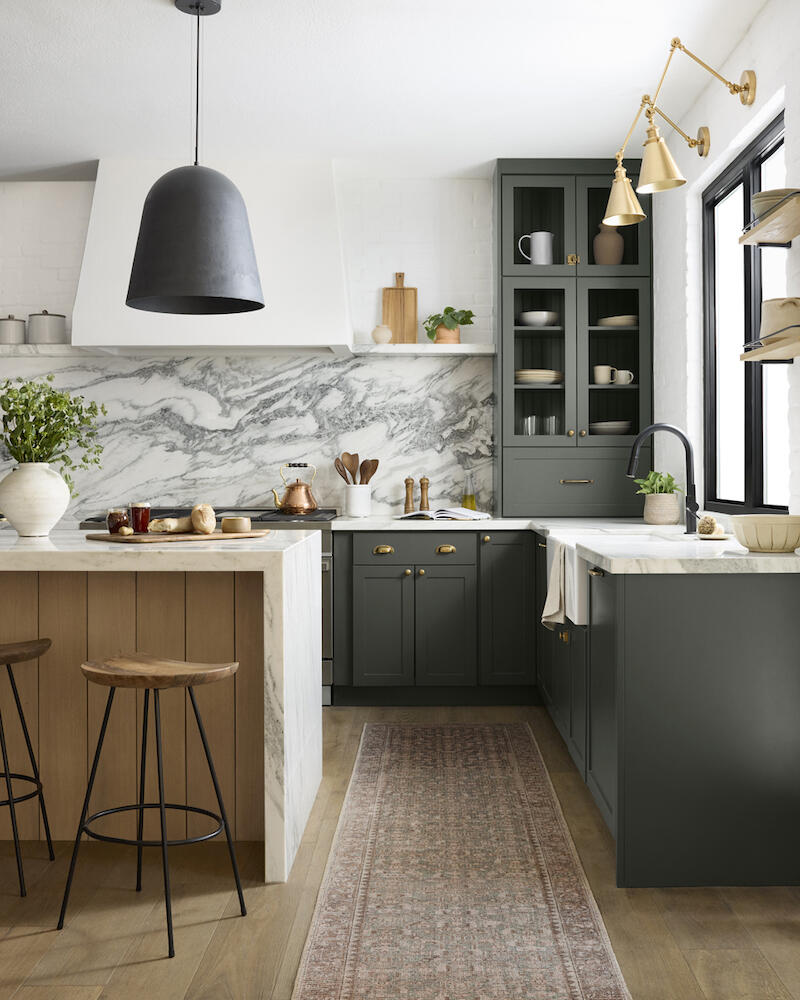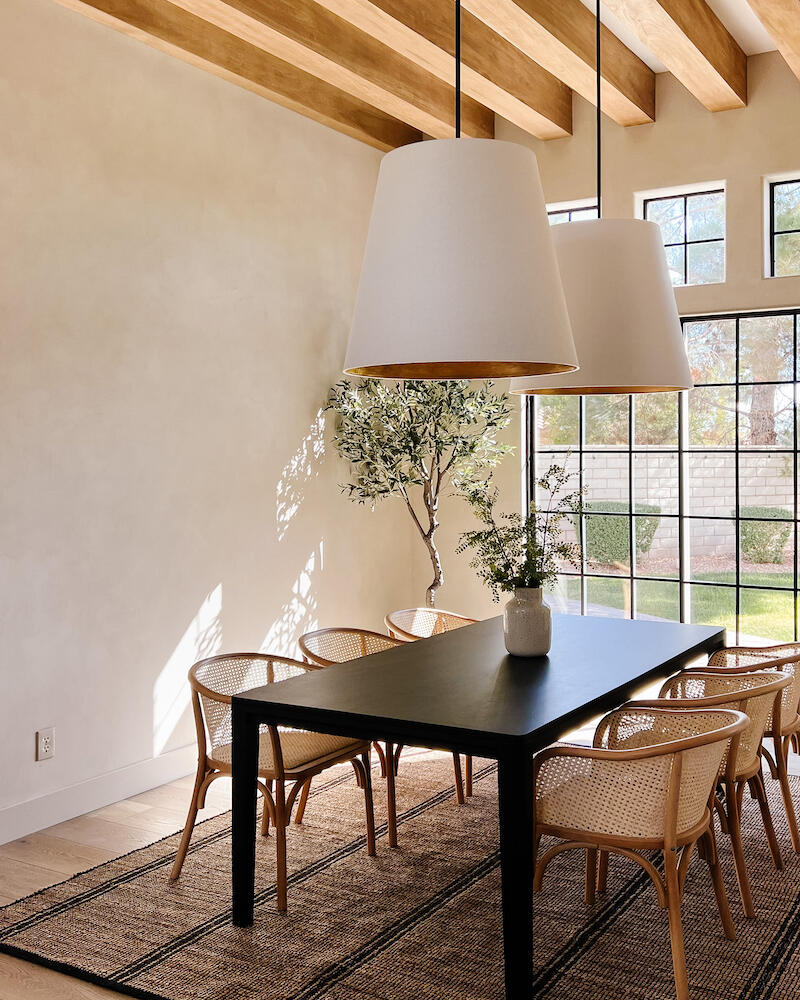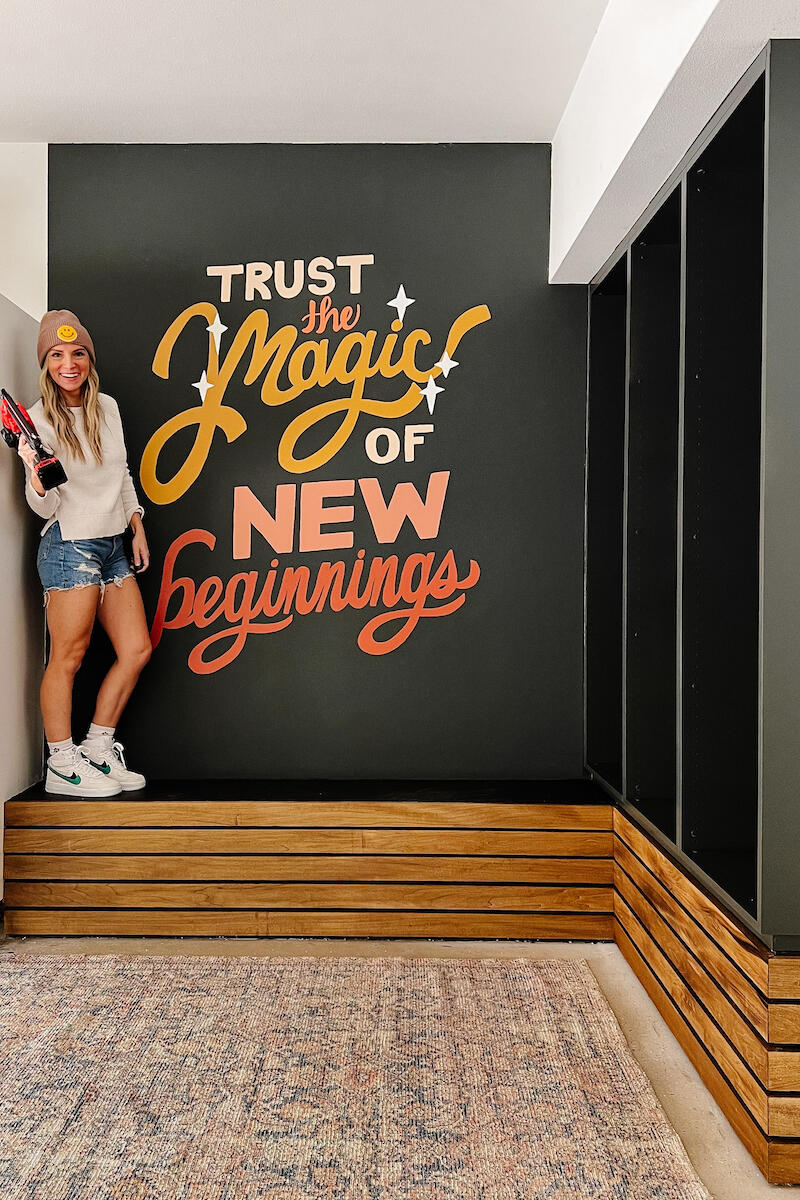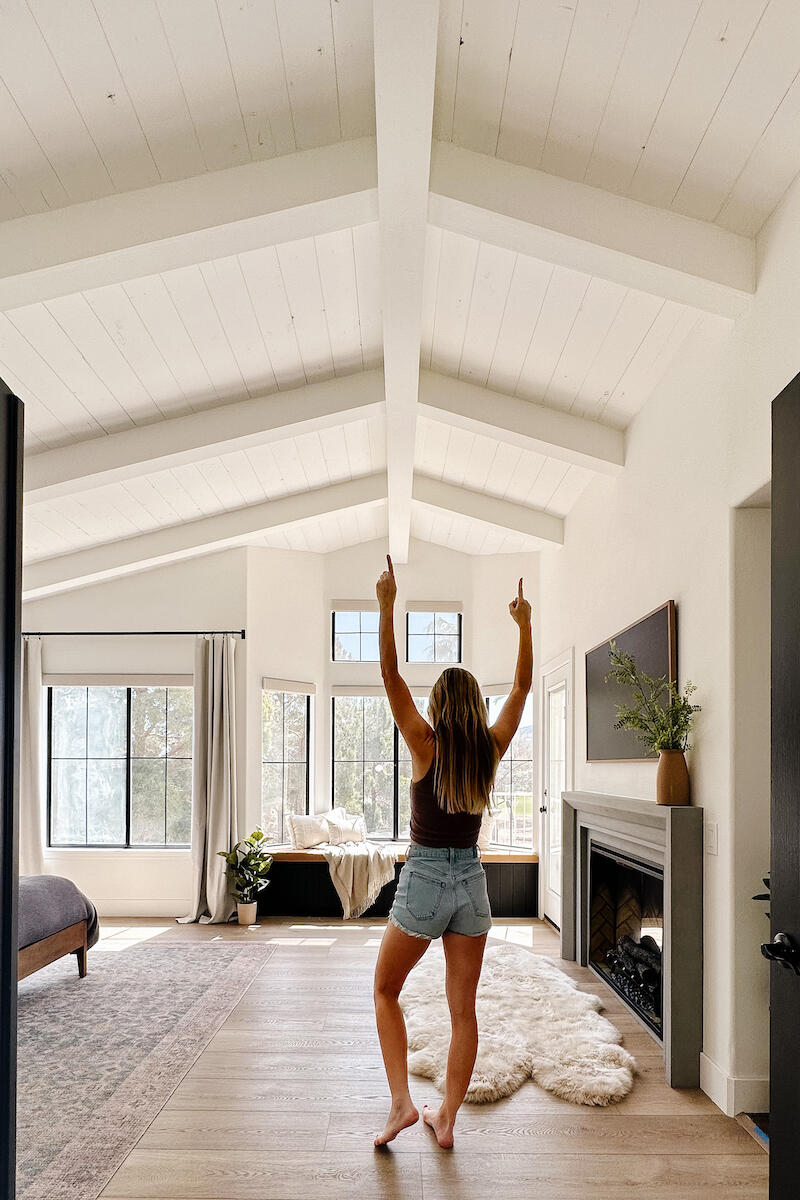In Ask an Influencer, Business of Home explores the creator economy. This week, we spoke with Angela Rose, the Las Vegas–based design and DIY influencer whose accessible approach to design has attracted an online community of more than a million followers.
For Angela Rose, the road to social media stardom started with a Pottery Barn bed. More than a decade ago, Rose was working a communications job in the corporate world and ready to upgrade her postgrad furniture when the price tag on the bed in question stopped her dead in her tracks. As she came across some construction plans for a nearly identical bed online, the realization hit her: “I bet I could do this.” A short trip to Home Depot and a few hours of woodworking later, Rose had built the bed of her dreams.
“Literally everything inside my body and my mind said, ‘You love this,’” says Rose. “I thought maybe I would be a furniture-maker, but what I loved was achieving a look that was out there and that felt attainable. That became my quest—it’s how I got hooked on it.”
In April 2018, Rose launched an Instagram account called Angela Rose Home to document her adventures in DIY home renovation. There, she also put her early career background to work by crafting stories that kept her followers—now numbering 1.5 million—tuned in for the latest chapters of her life. The end result is a mix of design content interspersed with everyday highs and lows, along with an overarching call to action: Don’t wait for the perfect house or apartment to build your dream space.
Ahead, Rose shares why she avoided brand deals during her first two years on social media, how she creates a personal connection with her audience without sacrificing her private life, and why her goal is to build a business that’s bigger than just one platform.


What was the path to starting your design career?
I worked in communications, marketing and PR for a few years postcollege, and then my oldest child was diagnosed on the autism spectrum and I quit my job to manage his autism therapy. It was a time in my life when there were a lot of unknowns, and it was scary and hard. I put all my focus into my child, getting the resources and help that he needed—we’d be in and out of therapy for 35 hours a week. I would sit there, and to calm myself down I would stare at these spaces in my house every night and dream of what they could be. I would erase it in my head, redo it, erase and redo it. It became my outlet, like, “This is something that I can control.”
It also got my brain in the practice of looking at my child and seeing his potential, and what he could be and what we could work toward, envisioning his future—and I was doing the same thing with spaces. I had this parallel journey. That’s why I have such an emotional tie to my spaces, because they take on whatever I’m going through at the time, and that’s a vulnerable feeling. [Before his diagnosis,] there were a lot of givens and knowns in my future, and all of a sudden, everything turned into question marks. It really forced me into a creative space. Instead of thinking, “Oh, I’ll do that later on,” you take ownership over your happiness and your surroundings, and you’re like, “No, nobody’s doing this for me. It’s me.”
When did you launch a presence on social media?
A whole 10 years after the autism diagnosis and after I started building things. I was a full-time autism therapy mom for a really long time. Five years ago, my kids were settled and in a very good spot with school, and my youngest baby girl had just turned 1. That intense period of therapy in my life was lightening up, and I felt this pull, like, “This is time for me to do something.” I knew that I wanted it to be home-related.
I remember sitting in a room full of friends, and there was a distinct moment when everyone was talking about what we wanted in our homes. It was like, “In my dream kitchen, I want this,” and “One day, when we get this job, or move into this house…” Everything was all getting pushed off to some arbitrary date. I had this breaking point inside: What are we all waiting for? Do we really think that in five years, when we get that dream situation, we’re going to be happier? The time is right now. Figure it out now, whatever space you’re in. You make it a place that you love and a place that you’re proud of, and you turn it into that dream home. Most people will never get that $2 million home, and that’s not actually going to make us happy anyway. If somebody handed me a perfectly finished home with all the perfect things, I don’t think it would make me any happier than this room that I’ve spent the last four months building out by myself with my own hands. I appreciate this because of the work and love and intention that’s gone into it.
I started posting online, thinking I need to be just like all these perfect designers with their Pinterest images, and everything needs to be perfect. Then I said, “Forget this. I’m doing this my way.” On Instagram at the time, there were just beautiful pictures, but nobody was doing anything in Stories. I remember telling my friends, “I’m going to show the process. I’m going to post pictures in the middle of the design process, and I’m getting in the photo. It’s not just going to be the final space—I’m showing my face. I’m showing the messy middle.” The story is what makes this important, not the final image. I did it my way, and the beautiful thing about my business is that it was birthed from what I loved and what I was passionate about, and it snowballed into an entire community.
When did you realize social media was a business opportunity for you?
Within the first couple weeks, I realized the only way I know how to do things is 400 percent. I was like, “I’m making this a full-time job starting now.” I started with zero followers, but I took it dead serious from day one. It took me four months to get to 1,000 followers, and then I started joining up with other Instagrammers in my space, and we started pulling together our efforts to help each other grow and be successful. What’s cool about the DIY home space is that it’s very collaborative—the reason we are successful is because we all helped each other out, and we all grew together. It took seven months for me to hit 10,000 followers, and it just started snowballing.
I had it in my mind always that Instagram growth was my number-one goal—providing value and good content was what I wanted, but Instagram growth was my focus, so I didn’t take a penny from any brand for the first two years. At first it was joining up with my friends and us doing a project together, or sharing each other’s accounts. I would replicate my idols’ projects on Instagram and say, “Hey, look, I did your project,” and then they would share it. I also took very cool designer things—like a Joanna Gaines barn door that I saw in a screenshot—and I figured out a way to make it, and that went viral. I told myself, “Come up with really creative content, do things right, do projects systematically that are going to get liked and noticed, and maybe shared by accounts that are larger than you, and just keep collaborating with your friends.” At one year, I had around 100,000 followers, and then I hit like a million a couple years ago. Now I’m at 1.5 million.
What went into your decision to avoid brand deals during those first two years?
What comes in [first] is the offering of free products in exchange for posts. I saw that my time was valuable: If people were asking me to give them all this content in exchange for, say, $100 worth of their product, I’m going, “My time is more valuable than that, and I want to grow an audience that knows that I am here because I love this, not because I want to make money.”
When you start working with brands, it takes up so much time. Some weeks, I feel like I’m only working five hours on a project and 60 hours behind the scenes with brands. It’s really hard to grow your business and do projects when you’re the one on a camera and the one creating things—especially when your energy is being put into brand deals. I [decided] my energy was 100 percent going into awesome content and growing this, to make it so that once I do start taking brand deals, the money is worth it. I had the luxury to do that [at the beginning] because my husband had a job. But then at some point, maybe 70,000 followers or something, I had drained our savings down to almost zero, and I remember looking at my husband and going, “This is going to be worth it. Do you trust me?” That next month, I got my first check from a brand.
What does your business look like today?
My business is still pretty much [designing] my own home, with random [external] weekend makeovers [sprinkled in]. The income comes through affiliate brand partnership deals and product lines, blog ads and things like that. I’ve sold some [design] plans online before; I’ve done some T-shirts and merch, but that’s faded into the background.
How do you work with brands?
I’m very picky about who I work with. I have an audience that trusts me, so it has to be something that I genuinely have used and trust. If it’s an Instagram story ad, I vet all the products and I don’t agree to anything unless I know what it is. If it’s a product line, that has to be a close fit into my brand. It has to solve a need for my audience. I have a flooring line and a rug line—all of [my products] are home-related. [My followers] can replicate these beautiful looks, and they’re affordable and reasonable, so it helps people get over that barrier to entry.
I always say, “I’m your human guinea pig. I do all the research and make all the mistakes. If I’m recommending it, you know it’s going to be good.” For a product line, I look at who the brand is, and if it’s one that I’ve been using—like with Loloi, almost like every single rug in my house was Loloi. I loved the way that they were able to be at the forefront of the industry and be able to replicate these looks, and do them in a durable, affordable way. I hadn’t seen it anywhere else, and I just respected them as a company, and I knew that it would be a great collaboration because I’d learned a lot and [could] bring a lot to the table.
How do you decide what your rates are for different partnerships?
It’s really hard in this space because it’s like the Wild West. Ten years ago, this space didn’t exactly exist, and every year it changes so much. That’s where connecting with a bunch of people in your community is really helpful. I took a couple of classes on how to make your own media kit, and I would pitch myself to brands. I researched to come up with my rate, plus talked to a few friends that were a couple of years ahead of me or had at least tested the waters. You kind of just guess—and if it’s accepted super fast, then you know, “Well, maybe I undercharged.” So next time, you increase it a little bit more. I started with brands that I wanted to work with, like Home Depot or Lowe’s, and products like Rust-Oleum and Minwax. I was pitching all the homebuilding products at first and getting turned down sometimes. Then it was a matter of talking to other friends, who said, “Oh, you’re getting this right,” or “Oh, they’re asking for this—OK.” You just learn as you go.


Do you have a content schedule?
I am always posting what’s happening that day. The engine of my business is what part of the house I’m working on, and people tune in to see the updates on that. Within that is all of the color commentary on me as a human and [my] story, how I’m feeling and what my followers are reacting to. I have a basic structure for what projects I will be [posting], but then the content that I actually create comes up as it happens.
What does the physical process of producing content look like for you?
I film everything on my iPhone. I have two work iPhones, so I can set up one as a time lapse and then one just to record me close-up, and then I have a personal phone. I use tripods, because I’m doing most of my own filming. I recently hired someone [to do] photography, videography, editing and creative, so they’ll also come in and we’ll batch some content to post.
I use an app called Splice to edit videos and post them to my Instagram Stories, because I want to have control over the music and the feelings and the captions. I am very protective of my Instagram Stories. I will let people on my team post TikToks or YouTube shorts, but nobody touches my Instagram Stories. I’m willing to give up more control on some social media platforms than others.
How much of your personal life makes it onto your page?
This is really challenging, and it is something that I am very intentional about, because I do share personal things. I got divorced last year, and I have kids on the autism spectrum, and I want to respect their privacy, but I also want to be able to relate to people and connect with them. So I do share personal things, but I always ask myself, “What’s my intention behind this?” And if it connects, that’s good. If it’s just to get a reaction, then no.
I also tell myself, “Share your feelings about it, but they don’t have to know the details.” Nobody knows the reason for my divorce. Nobody knows why I moved into this house and why I didn’t stay in my last house. But they know my feelings, because that’s what people relate to. They can deal with being curious, but what I want is for them to connect with me. With my kids getting older, I’m very careful about sharing about autism. I share about autism awareness, and I encourage people to get their children evaluated if they have concerns. But I don’t share details on my kids and why I got them diagnosed, and exactly how their therapy went and exactly how they’re doing. I keep them out of it.
Do you ever encounter trolls?
There are people that say mean things all the time, and I don’t breathe any air into it ever. I don’t even respond to those comments. I delete and block. My page is a place that’s real, but also light and positive. Sometimes people say mean things, and you want to repost and get people to rally around you, but I believe that what you put out is what you get back. I feel like I have the kindest corner of the internet. [My followers are] super supportive. I regularly say, “Thank you so much for showing up and supporting me and caring about me. I’m rooting for you guys too.” My community feels like a group of people who are all encouraging and building each other up, because that’s what I shine the light on.
What’s your policy with responding to comments and DMs?
I’ve always been very engaged with comments and DMs. I have an assistant who helps with some things—she’ll send me patterns, like, “Everybody’s asking about this and this”—but I like to go through and temperature check. For every 100 DMs, I’ll go and open up like seven, so I can see what people are thinking and feeling. I like to personally respond to as many as I can.
What are your thoughts on algorithm shifts and platform updates?
I feel like Instagram is a video game, and every few months the game changes, and it is exhausting. It is frustrating—I felt like I had the game figured out perfectly a couple years ago. Then it swung in a crazy different direction in the past year, and I’ll sometimes see my Story views cut in half overnight for no reason. This is part of the game that we have to play, and you have to be flexible and just move with it and shift with it, or you’re going to get left behind.
Does social media ever get overwhelming for you?
It is not great for emotional health. Anybody who has consistently produced content for a social media platform knows it messes with your head and [pushes] you to be constantly performing—to constantly feel like you did something yesterday, but what are you doing next? You feel like you’re on a stage all the time. It helps to [be] as authentic as possible, but I ultimately would love to have social media as a vehicle that’s less about having to show up every single day. It takes an emotional toll to take fully grown, confident humans and stick numbers over them. It’s a very tough space, and it’s a lot harder than it looks emotionally and physically.
Did your life change when you started to build a following?
I had been a stay-at-home mom for 10 years, and then my life changed in so many ways. A lot of the reason I started social media was because I felt kind of alone—I didn’t have a lot of friends and I just felt a little different. But [on social media,] I found people whose minds worked like mine, and they were interested in the same things as me. It took me until age 34 to find my best friends.
It also changed in terms of being recognized in public and knowing that people were watching me everywhere. Now everywhere I go, there is usually one person who recognizes me. I sometimes feel a little bit paranoid.
[Social media has also] opened up a whole world of possibilities. I dream up so many cool things now, but my role within my family has shifted. I was just home with kids, and now I’m providing and growing a business, and my kids are watching me grow this business. You want to be able to exist outside of it, but you can’t extract work from personal—they blend together. You want to know that people care about you not for numbers. I’ve been craving and cultivating really close friendships and relationships. People think, “She has millions of followers, so she’s always hanging out with people.” But oftentimes, I’m alone, and nobody invited me to, like, a Super Bowl party. So there’s an emotional piece where sometimes the more people that are in your following, sometimes a little bit more alone you feel. There’s a business aspect to it, and then there’s a personal struggle with it as well.
What are you struggling with or analyzing most about your social media activity today?
I have Instagram figured out, and now I want to diversify. I want to be around in 20 years, which means I want a business that’s bigger than one platform, or even than social media. I don’t want to be an influencer—I want to be a whole brand. I’ve been working really hard at pushing my business and using social media as an engine, but now growing and expanding it so I have income and opportunities in other areas. Maybe it’s through Airbnb, maybe it’s the product lines, or a TV show.
It’s hard because I keep having to show up every day on Instagram Stories, so I’m running on a hamster wheel. But you can’t run on a hamster wheel for 20 years, so I need to step off for a second, evaluate my business as a whole, and say, “Where do I want to be? What do I want this to look like in this many years? What are the pieces that I need to put in place to get there?” I would love to always be on Instagram, but I want it to be on my own terms.
Homepage image: Angela Rose | Courtesy of Angela Rose





























